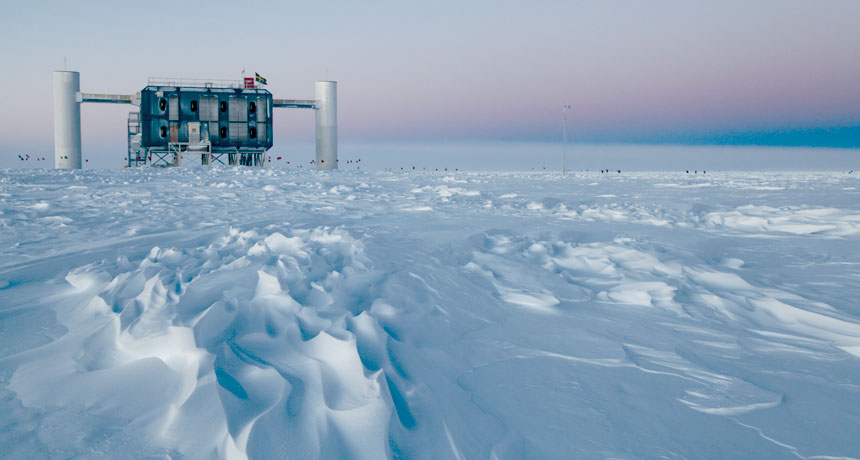
NEUTRINO CENTRAL The IceCube Laboratory near the South Pole collects data from nearby underground sensors and picks out the detections most likely to have been triggered by neutrinos from deep space.
Sven Lidstrom, IceCube/NSF
SAVANNAH, Ga. — High-energy neutrinos from as far as the edge of the observable universe are pelting Earth from all directions, researchers announced April 7 at a meeting of the American Physical Society. The conclusion is based on a new analysis of data from IceCube, the enormous underground experiment near the South Pole that detected the first high-energy space-borne neutrinos in 2013.
“It’s a very important step,” says Keith Bechtol, an astrophysicist at the University of Chicago, who was not involved in the research. “IceCube neutrinos open a window into the very distant and high-energy universe that is extremely difficult to access by any other means.”
Neutrinos, unlike every other subatomic particle, provide that window because they are electrically neutral and rarely interact with matter. By detecting these particles and charting the directions they come from, scientists aim to identify the sources of neutrinos: star-forming galaxies, supermassive black holes or perhaps some unknown violent objects. These sources can accelerate neutrinos and other subatomic particles to energies far greater than any human-made machine could achieve.
IceCube was specifically built to aid in that quest. For three years, strings of sensors stretching as deep as 2.5 kilometers below the surface of an Antarctic glacier have detected subtle flashes of light created when neutrinos and other particles collide with atoms. Last year, IceCube researchers identified 28 high-energy neutrinos from all directions that are almost certainly from outside the solar system (SN: 12/28/13, p. 6). The researchers have since found nine more, including the highest energy neutrino ever detected (SN Online: 4/7/14).
To complement this painstaking search for the highest energy neutrinos, Christopher Weaver, an IceCube physicist at the University of Wisconsin-Madison, decided to cast a wider net for the larger population of slightly lower-energy astronomical neutrinos. His approach relied on selecting particles that fell from the skies of the Northern Hemisphere, whizzed through Earth’s interior and arrived at IceCube from below. Only neutrinos, and not other particles that often trigger IceCube’s sensors from above, can make it through Earth’s dense crust and core.
Weaver also limited his search to detections at a specific energy – about 100 trillion electron volts –so that the number of neutrinos from space wouldn’t be dwarfed by the amount of neutrinos produced in the atmosphere. (IceCube’s sensors can’t distinguish between the two.)
That left Weaver with about 35,000 neutrinos, at least some of which began their journeys beyond the solar system. He tracked the directions they came from and found no evidence of clustering in any particular parts of the sky – a finding that confirms previous analyses and suggests that no local source is primarily responsible for the population of neutrinos whizzing by Earth. “Most likely a lot of them are from beyond the galaxy,” says Nathan Whitehorn, a Wisconsin astrophysicist who worked with Weaver on the research. “It’s quite possible they come from the edge of the universe.”
As IceCube continues to collect more data, Whitehorn and his colleagues hope the two independent neutrino search methods will converge on trends in the neutrinos’ direction of arrival. Bechtol suggests that the IceCube researchers also look at observations of gamma rays, high-energy radiation that is produced in extreme environments. Within the next several years, all those data could allow scientists to pinpoint nature’s most powerful particle accelerators. “It’s a really exciting time,” Bechtol says.







